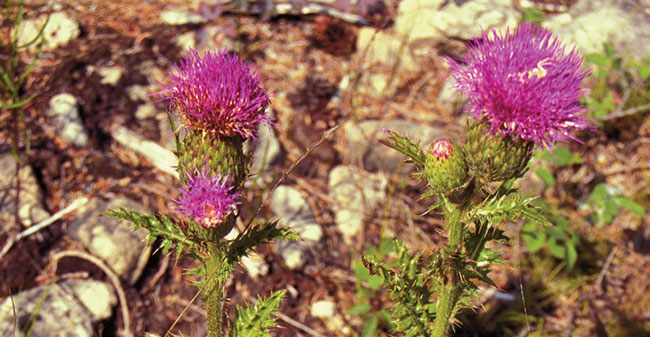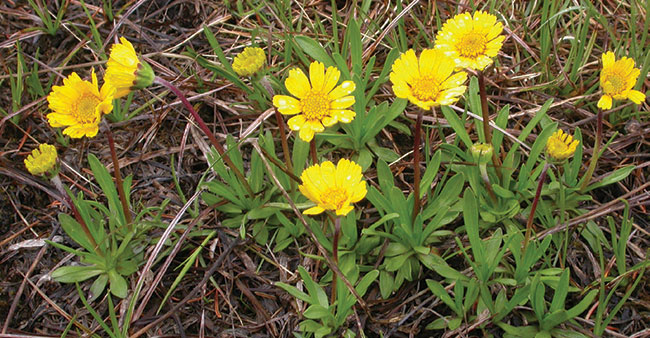Hill’s Thistle and Lakeside Daisy government response statement
Ontario’s policy direction for the protection and recovery of Hill’s Thistle and Lakeside Daisy.
Publication date: March 14, 2014
Hill’s Thistle is a perennial plant that lives up to five years as sterile rosettes of leaves, until the last year when they produce an upright stem and a single large mauve flower head.

Photo: Wasyl Bakowsky
Lakeside Daisy is a low growing perennial consisting of several small leafy rosettes, a shortfive to 15 cm stalk, dark green leaves, and yellow inflorescence.

Photo: C.D. Jones, NHIC Archives
Protecting and recovering Species at Risk in Ontario
Species at risk recovery is a key part of protecting Ontario’s biodiversity. Biodiversity – the variety of living organisms on Earth – provides us with clean air and water, food, fibre, medicine and other resources that we need to survive.
The Endangered Species Act, 2007 (ESA) is the Government of Ontario’s legislative commitment to protecting and recovering species at risk and their habitats. As soon as a species is listed as extirpated, endangered or threatened under the ESA, it is automatically protected from harm or harassment. Also, immediately upon listing, the habitats of endangered and threatened species are protected from damage or destruction.
Under the ESA, the Ministry of Natural Resources (the Ministry) must ensure that a recovery strategy is prepared for each species that is listed as endangered or threatened. A recovery strategy provides science-based advice to government on what is required to achieve recovery of a species.
Government response statements
Within nine months after a recovery strategy is prepared, the ESA requires the Ministry to publish a statement summarizing the government’s intended actions and priorities in response to the recovery strategy. The recovery strategies for Hill’s Thistle (Cirsium hillii) and Lakeside Daisy (Tetraneuris herbacea) in Ontario were completed on May 31, 2013 (http://www.mnr.gov.on.ca/stdprodconsume/groups/lr/%40mnr/%40species/documents/document/mnr_sar_rs_lksd_dsy_en.pdf [link inactive]).
The response statement is the government’s policy response to the scientific advice provided in the recovery strategy. All recommendations provided in the recovery strategy were considered and this response statement identifies those that are considered to be appropriate and necessary for the protection and recovery of the species. In addition to the strategy, the response statement is based on input from stakeholders, other jurisdictions, Aboriginal communities and members of the public. It reflects the best available traditional, local and scientific knowledge at this time and may be adapted if new information becomes available. In implementing the actions in the response statement, the ESA allows the Ministry to determine what is feasible, taking into account social and economic factors.
Given their similar distribution and threats, the recovery efforts for Hill’s Thistle and Lakeside Daisy are addressed collectively in a single government response statement.
Moving forward to protect and recover Hill’s Thistle and Lakeside Daisy
Hill’s Thistle and Lakeside Daisy are listed as threatened species under the ESA, which protects both the plants and their habitats. The ESA prohibits harm or harassment of the species and damage or destruction of their habitat without authorization. Such authorization would require that conditions established by the Ministry be met.
In Canada, Hill’s Thistle is restricted to the areas of Simcoe County, Bruce County, and the Manitoulin Island region in Ontario, occurring in a total of 93 sites. Hill’s Thistle requires open habitat to survive and is commonly found in prairies, sand barrens, oak and jack pine savannas, open woodlands, at the backs of dunes and in some types of alvars. In Canada, Lakeside Daisy occurs at 29 sites in the Bruce Peninsula and Manitoulin Island regions of Ontario. The species' Canadian distribution has been estimated to account for 95 percent of its global distribution. The remainder of the species' global distribution is accounted for with six sites in the United States, some of which are re-introductions. Given that Lakeside Daisy occurs predominantly within Ontario, there is an increased priority for the implementation of its recovery actions. Lakeside Daisy is most commonly found growing in alvar ecosystems or on limestone bedrock shorelines similar to alvars.
In Canada, Hill’s Thistle is restricted to the areas of Simcoe County, Bruce County, and the Manitoulin Island region in Ontario, occurring in a total of 93 sites. Hill’s Thistle requires open habitat to survive and is commonly found in prairies, sand barrens, oak and jack pine savannas, open woodlands, at the backs of dunes and in some types of alvars. Lakeside Daisy is found in Canada at 29 sites in the Bruce Peninsula and Manitoulin Island regions of Ontario, which has been estimated to account for 95 percent of the species' global distribution. The remainder of the species' global distribution is accounted for with six sites in the United States, some of which are re-introductions. Lakeside Daisy is most commonly found growing in alvar ecosystems or on limestone bedrock shorelines similar to alvars.
Hill’s Thistle and Lakeside Daisy are threatened by loss of suitable habitat, primarily due to human impacts including building and road construction, trampling by pedestrians, all- terrain vehicles, and heavy machinery used for logging, and aggregate extraction. Lakeside Daisy is also threatened by the introduction of invasive species. The human suppression of natural fires is also a potential threat to Hill’s Thistle and Lakeside Daisy habitats. This suppression can lead to the emergence of other vegetation, resulting in isolated habitat patches, low-light levels, and higher competition for ground space and nutrients. Current population trends are unknown for both Hill’s Thistle and Lakeside Daisy because no long- term monitoring has been undertaken for either species. Although population trends are not known, there is an assumed overall, continuous decline in the Canadian populations of Hill’s Thistle and Lakeside Daisy due to habitat loss from threats.
The government’s goal for the recovery of Hill’s thistle and Lakeside daisy is to halt the declines in population size for each species and to enable population increases to self- sustaining levels across each of the regions where the species are found.
Protecting and recovering species at risk is a shared responsibility. No single agency or organization has the knowledge, authority or financial resources to protect and recover all of Ontario’s species at risk. Successful recovery requires inter-governmental co-operation and the involvement of many individuals, organizations and communities.
In developing the government response statement, the Ministry considered what actions are feasible for the government to lead directly and what actions are feasible for the government to support its conservation partners to undertake.
Government-led actions
To help protect and recover Hill’s Thistle and Lakeside Daisy, the government will directly undertake the following actions:
- Continue to manage the habitat of Hill’s Thistle and Lakeside Daisy in provincially protected areas to maintain the ecological integrity of their alvar and open and grassy habitats, and to minimize the threat of recreational pressures and impacts caused by all-terrain vehicles, mountain bikes, pedestrian trampling, and invasive species.
- Collaborate with federal partners to enable consistency between provincial and federal recovery efforts.
- Educate other agencies and authorities involved in planning and environmental assessment processes on the protection requirements under the ESA.
- Encourage the submission of Hill’s Thistle and Lakeside Daisy data to the Ministry’s central repository at the Natural Heritage Information Centre.
- Undertake communications and outreach to increase public awareness of species at risk in Ontario.
- Protect Hill’s Thistle and Lakeside Daisy and their habitats through the ESA.
- Support conservation, agency, municipal and industry partners, and Aboriginal communities and organizations to undertake activities to protect and recover Hill’s Thistle and Lakeside Support will be provided where appropriate through funding, agreements, permits (including conditions) and/or advisory services.
- Establish and communicate annual priority actions for government support in order to encourage collaboration and reduce duplication of efforts.
Government-supported actions
The government endorses the following actions as being necessary for the protection and recovery of Hill’s Thistle and Lakeside Daisy. Actions identified as "high" will be given priority consideration for funding under the ESA. Where reasonable, the government will also consider the priority assigned to these actions when reviewing and issuing authorizations under the Endangered Species Act. Other organizations are encouraged to consider these priorities when developing projects or mitigation plans related to species at risk. The government will focus its support on these high-priority actions over the next five years.
Focus area: Research and monitoring
Objective: Increase knowledge about the population trends, threats, and habitat needs for Hill’s Thistle and Lakeside Daisy.
Actions:
- ( High) Develop and implement a standardized long-term monitoring program at priority sites in order to:
- determine population trends and demographics;
- assess all known and potential threats; and,
- document the response of Hill’s Thistle and Lakeside Daisy to management techniques.
- Conduct research to determine the impacts that disturbances such as wildfire, flooding, and drought have on the species' population dynamics.
Focus area: Protection and management
Objective: Engage landowners and Aboriginal communities in site stewardship to manage threats and protect Hill’s Thistle and Lakeside Daisy habitats.
Actions:
- ( High) Develop and distribute best management practices for landowners, land managers, municipalities, and Aboriginal communities to minimize or address impacts to Hill’s Thistle and Lakeside Daisy and their habitats. Actions may include:
- erecting barriers, designating walkways, and constructing boardwalks to reduce trampling by pedestrians and all-terrain vehicles;
- where development occurs, implementing project designs that do not interfere with the natural processes that maintain habitat;
- restoring degraded habitat at current locations; and,
- posting informative signage in and around alvars and other areas of suitable habitat.
- Implement and monitor the effectiveness of using controlled burns as a tool to manage the threat of habitat loss due to the encroachment of competing vegetation.
- Assess the risk posed to Hill’s Thistle and Lakeside Daisy by invasive species (e.g. Common St. John’s Wort, Mossy Stonecrop, Canada Bluegrass and White Sweet Clover) and where appropriate, implement invasive species control within and around habitat.
- As opportunities arise, support the securement of Hill’s Thistle and Lakeside Daisy habitat through existing land securement and stewardship programs.
Focus area: Awareness and outreach
Objective: Increase public awareness about the protection and recovery needs of Hill’s Thistle and Lakeside Daisy.
Actions:
- Collaborate with local partners such as Aboriginal communities and organizations, stewardship councils, fish and game clubs and other interest groups to develop communications to increase public awareness of the protection and recovery needs of Hill’s Thistle and Lakeside Daisy and what actions individuals can take.
Implementing actions
Financial support for the implementation of actions may be available through the Species at Risk Stewardship Fund, Species at Risk Research Fund for Ontario, or the Species at Risk Farm Incentive Program. Conservation partners are encouraged to discuss project proposals related to the actions in this response statement with the Ministry. The Ministry can also advise if any authorizations under the ESA or other legislation may be required to undertake the project.
Implementation of the actions may be subject to changing priorities across the multitude of species at risk, available resources and the capacity of partners to undertake recovery activities. Where appropriate, the implementation of actions for multiple species will be co-ordinated across government response statements.
Reviewing progress
The ESA requires the Ministry to conduct a review of progress towards protecting and recovering a species not later than five years from the publication of this response statement. The review will help identify if adjustments are needed to achieve the protection and recovery of the Hill’s Thistle and Lakeside Daisy.
Acknowledgement
We would like to thank all those who participated in the development of the "Recovery Strategy for Hill’s Thistle (Cirsium hillii) in Ontario" and the "Recovery Strategy for Lakeside Daisy (Tetraneuris herbacea) in Ontario" for their dedication to protecting and recovering species at risk.